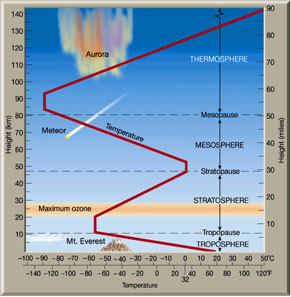Question: Explain about the layers of the atmosphere with the help of a well labelled diagram.
Answer: The layers of atmosphere are:
Troposphere:
- It is the lowest layer of the atmosphere. In this layer temperature and pressure fall with the increase in height.
- The troposphere is the densest zone of the atmosphere. Three-fourths of the atmosphere is found within 11 km of the surface of the Earth, including most of the oxygen we need to breathe
- The average thickness (altitude or height from the surface of the Earth) of the troposphere is 13 km. The thickness varies from about 8 km at the poles to 18 km near the equator.
- The troposphere is known as the weather making zone. All the physical process like wind, rain, storms, clouds, fog, mist and hail occurs here.
- The upper limit of the troposphere is called the tropopause.
Stratosphere:
- The layer just above the troposphere is called the stratosphere. It extends up to 50 km.
- The temperature here is constant for a few kilometers to begin with and then it rises gradually.
- It is a clear and dry zone which is largely devoid of weather phenomena.
- There are no clouds here and no storms. These factors make it the ideal zone for jet planes to fly in.
- The lower part of the stratosphere between the altitudes of 15 and 30 km, there is a thin layer of the gas ozone.
- Ozone plays a very important role-it absorbs harmful ultraviolet rays.
- The upper limit of the stratosphere is called stratopause.
Mesosphere:
- The third layer of the atmosphere is called the mesosphere. It lies above the stratosphere.
- It extends from around 50 to 80 km. The temperature here starts decreasing once more.
- Meteoroids, i.e., rock fragments travelling in space, burns up when they pass through this part of the atmosphere.
- Some meteoroids survive their journey through the atmosphere and strike the surface of the Earth. They are called meteorites.
- The upper limit of the mesosphere is called Mesopause.
Thermosphere:
- The thermosphere is the part of atmosphere that lies beyond the mesosphere. It is divided into two layers- the ionosphere and the exosphere.
- The ionosphere is the lower part of the thermosphere. It lies above the mesopause.
- It extends from 80-640 km. Temperature rises sharply here.
- The ultraviolet radiations from the Sun break the gas molecules in this layer into electrically charged ions. Therefore, the ionosphere is full of electrically charged ions, which enable wireless transmission.
- Radio waves transmitted from the Earth are reflected back to the Earth by these ions.
- The upper limit of ionosphere is called the ionopause.
- The exosphere lies beyond the ionopause and is the uppermost layer of the thermosphere.
- The upper limit of the exosphere is difficult to determine. it merges with inter-planetary space.
- The temperature here is estimated to be beyond 5500° C.
- The air is very thin here and its density is very low. Only lighter gases like helium and hydrogen are found here.
Question: What is the importance of carbon dioxide in the atmosphere?
Answer: Carbon dioxide is important because of its ability to absorb heat. It is responsible for the green house effect on Earth. The amount of carbon dioxide exhaled by humans and animals is almost equal to amount absorbed by the plants.
 Class Notes NCERT Solutions for CBSE Students
Class Notes NCERT Solutions for CBSE Students




